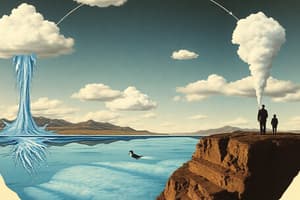Podcast
Questions and Answers
___________ happens in the atmosphere as water vapor changes to water droplets.
___________ happens in the atmosphere as water vapor changes to water droplets.
Condensation
___________ form as a result of condensation.
___________ form as a result of condensation.
- Clouds (correct)
- Evaporation
As part of the water cycle, water in lakes and rivers changes to water vapor through the process of?
As part of the water cycle, water in lakes and rivers changes to water vapor through the process of?
Evaporation
Which of these is important to the formation of clouds in the water cycle?
Which of these is important to the formation of clouds in the water cycle?
Between Point D (top of hill) and Point A (bottom of hill) on the diagram, how does most of the water move? (see pic)
Between Point D (top of hill) and Point A (bottom of hill) on the diagram, how does most of the water move? (see pic)
What is it called when water vapor is released from plants?
What is it called when water vapor is released from plants?
When white, puffy cumulus clouds appear in S.C., what type of weather will most likely occur that day?
When white, puffy cumulus clouds appear in S.C., what type of weather will most likely occur that day?
What forms when water vapor condenses directly onto a surface?
What forms when water vapor condenses directly onto a surface?
Depending on weather conditions, __________ falls as rain, snow, freezing rain, sleet, or hail.
Depending on weather conditions, __________ falls as rain, snow, freezing rain, sleet, or hail.
What happens in the atmosphere as water vapor changes to water droplets?
What happens in the atmosphere as water vapor changes to water droplets?
Which of these is important to the formation of clouds in the water cycle?
Which of these is important to the formation of clouds in the water cycle?
Clouds that form at medium or low elevations and are puffy with flat bottoms are called?
Clouds that form at medium or low elevations and are puffy with flat bottoms are called?
Clouds that form at high elevations and are wispy, usually consisting of ice crystals, are?
Clouds that form at high elevations and are wispy, usually consisting of ice crystals, are?
Clouds that form at medium or low elevations and are spread out, layer upon layer, covering a large area are called?
Clouds that form at medium or low elevations and are spread out, layer upon layer, covering a large area are called?
Sometimes a cloud may form at or near the ground when the ground cools after a warm, humid day. What is this cloud called?
Sometimes a cloud may form at or near the ground when the ground cools after a warm, humid day. What is this cloud called?
Flashcards are hidden until you start studying
Study Notes
Water Cycle Processes
- Condensation: The atmospheric process where water vapor transforms into water droplets, leading to cloud formation.
- Evaporation: Water from lakes and rivers turns into vapor, contributing to the water cycle.
- Transpiration: The release of water vapor from plants, playing a role in atmospheric moisture.
- Runoff: Water movement between elevated areas (e.g., hills) towards lower areas, typically after precipitation.
Cloud Formation and Types
- Clouds: Form as a direct result of condensation; consist of numerous water droplets.
- Cumulus Clouds: Puffy with flat bottoms, typically indicating fair weather at medium to low elevations.
- Stratus Clouds: Layered clouds that spread out and cover large areas at medium or low elevations.
- Cirrus Clouds: High-altitude, wispy clouds usually containing ice crystals; less associated with precipitation.
- Fog: A cloud that forms at ground level when the ground cools, creating a blanket of moisture.
Precipitation and Weather
- Precipitation: Water falling from clouds in various forms including rain, snow, sleet, and hail, depending on climatic conditions.
- Weather Indicators: The appearance of cumulus clouds usually suggests fair weather conditions.
Additional Concepts
- Water can condense on surfaces, forming dew.
- The cooling of air is essential for cloud formation, as warm air must rise and cool to create condensation.
Studying That Suits You
Use AI to generate personalized quizzes and flashcards to suit your learning preferences.




